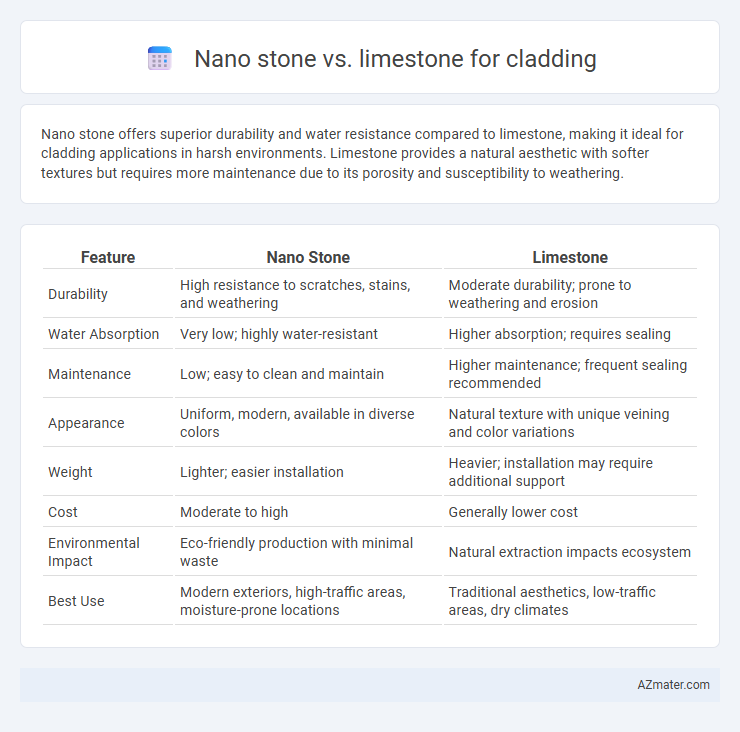Nano stone offers superior durability and water resistance compared to limestone, making it ideal for cladding applications in harsh environments. Limestone provides a natural aesthetic with softer textures but requires more maintenance due to its porosity and susceptibility to weathering.
Table of Comparison
| Feature | Nano Stone | Limestone |
|---|---|---|
| Durability | High resistance to scratches, stains, and weathering | Moderate durability; prone to weathering and erosion |
| Water Absorption | Very low; highly water-resistant | Higher absorption; requires sealing |
| Maintenance | Low; easy to clean and maintain | Higher maintenance; frequent sealing recommended |
| Appearance | Uniform, modern, available in diverse colors | Natural texture with unique veining and color variations |
| Weight | Lighter; easier installation | Heavier; installation may require additional support |
| Cost | Moderate to high | Generally lower cost |
| Environmental Impact | Eco-friendly production with minimal waste | Natural extraction impacts ecosystem |
| Best Use | Modern exteriors, high-traffic areas, moisture-prone locations | Traditional aesthetics, low-traffic areas, dry climates |
Introduction to Cladding Materials
Nano stone and limestone are popular cladding materials known for their durability and aesthetic appeal. Nano stone offers enhanced resistance to weathering and staining due to its advanced nanotechnology surface treatment, making it ideal for modern architectural applications. Limestone provides a timeless, natural texture with excellent thermal insulating properties, often preferred for traditional or historic building facades.
What is Nano Stone?
Nano stone is an innovative cladding material composed of ultra-fine particles that enhance durability, water resistance, and aesthetic appeal, making it ideal for modern architectural facades. Unlike traditional limestone, nano stone undergoes advanced nanotechnology treatments to improve strength, reduce porosity, and prevent staining, offering superior longevity for exterior surfaces. Its lightweight nature combined with enhanced protective properties positions nano stone as a high-performance alternative to conventional limestone cladding.
Overview of Limestone as a Cladding Material
Limestone is a durable, natural sedimentary rock widely used for cladding due to its aesthetic appeal and excellent weather resistance. Its porous texture allows for easy customization and enhances thermal insulation in building facades. As a versatile material, limestone offers a timeless, elegant look while maintaining strength and durability in various architectural applications.
Key Differences Between Nano Stone and Limestone
Nano stone offers enhanced durability and resistance to weathering compared to traditional limestone, making it ideal for exterior cladding applications. Limestone, a natural sedimentary rock, provides a classic aesthetic with a warmer, textured appearance but requires more maintenance due to its porosity. Nano stone's advanced manufacturing process results in a lightweight, low-porosity material that resists staining and erosion better than limestone.
Durability and Longevity Comparison
Nano stone cladding offers superior durability due to its advanced composite materials that resist weathering, scratches, and chemical damage more effectively than traditional limestone. Limestone, while aesthetically pleasing, is more porous and susceptible to erosion, staining, and surface degradation over time, reducing its overall longevity in harsh environmental conditions. Nano stone's enhanced resistance to environmental stressors ensures a longer lifespan and lower maintenance requirements compared to limestone in cladding applications.
Aesthetic Appeal: Nano Stone vs Limestone
Nano stone offers a sleek, modern aesthetic with its finely textured surface and consistent color palette, making it ideal for contemporary architectural designs. Limestone provides a natural, timeless look with unique fossil patterns and warm, earthy tones that enhance traditional and rustic exteriors. The choice between nano stone and limestone cladding ultimately depends on whether the design prioritizes modern uniformity or classic natural charm.
Maintenance Requirements
Nano stone cladding offers superior resistance to staining, weathering, and microbial growth, significantly reducing the frequency and intensity of maintenance compared to limestone. Limestone requires regular sealing and gentle cleaning to prevent erosion, discoloration, and damage due to its porous nature. Investing in nano stone cladding results in longer-lasting aesthetics and lower upkeep costs for exterior and interior applications.
Cost Analysis and Value for Money
Nano stone offers a higher initial cost compared to traditional limestone cladding, reflecting its advanced manufacturing process and durability. Limestone provides a more budget-friendly option but may require more frequent maintenance and replacement, increasing long-term expenses. Evaluating cost versus longevity, nano stone delivers better value for money through enhanced resistance to weathering and staining, reducing upkeep and replacement costs over time.
Environmental Considerations
Nano stone cladding offers superior environmental benefits compared to limestone due to its eco-friendly manufacturing process, which consumes less energy and generates lower carbon emissions. Limestone extraction often leads to habitat disruption and higher environmental degradation, including increased water usage and dust pollution. Utilizing nano stone also promotes sustainability by offering enhanced durability and reduced maintenance, thereby minimizing resource consumption over the product's lifespan.
Best Applications for Nano Stone and Limestone Cladding
Nano stone cladding excels in high-traffic commercial and exterior applications due to its enhanced durability, low porosity, and resistance to weathering and staining. Limestone cladding is ideal for residential interiors and facades requiring a natural, elegant appearance with moderate durability and ease of customization. Both materials provide aesthetic appeal, but nano stone's advanced properties make it preferable for harsh environments, while limestone suits decorative and less exposed architectural elements.

Infographic: Nano stone vs Limestone for Cladding
 azmater.com
azmater.com